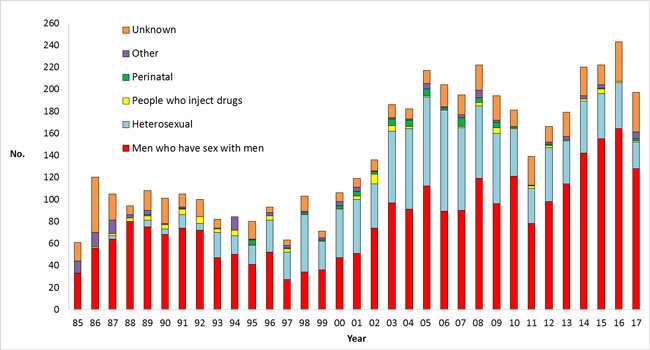Reduction in HIV diagnoses in New Zealand

There has been a significant reduction in the number of people diagnosed with HIV in New Zealand over the past year.
In 2017, 197 people were diagnosed – a decrease from the 243 reported in 2016, figures released today by the AIDS Epidemiology Group, University of Otago, show.
It is the first time there has been a reduction since 2011 however, leader of the AIDS Epidemiology Group, Dr. Sue McAllister, says it is important to put the result in perspective.
"While this decrease in the number of diagnoses is encouraging, it is too early to say whether this decline will be maintained."
Last year's numbers are now similar to the number of people diagnosed with HIV in the mid 2000's but is still an increase on numbers in 2012 and 2013.
Gay, bisexual and other men who have sex with men (MSM) were the group most affected. Of the 197 people diagnosed, 128 were MSM and 24 were heterosexually infected (similar number of men and women).
For most of the remainder, the means of infection was not reported, with only one person infected through injecting drug use and two people who had been infected through mother-to-child transmission overseas.
The reduction in the number of people diagnosed in 2017 was in both MSM (128 compared to 164 in 2016) and heterosexual men and women (24 compared to 42 in 2016).
Dr. McAllister says there have been some changes to the management of people with HIV which may have assisted in preventing the disease. Now HIV-infected individuals are able to start treatment immediately on diagnosis with the removal of the clinical threshold for receipt of subsidised anti-retroviral therapy. There is also now availability of pre-exposure prophylaxis to prevent infection for individuals at high risk of HIV.
"These new measures, along with use of condoms, regular and early HIV testing and screening and treatment for other sexually transmitted infections all need to be utilised in order to see a continued decline," Dr. McAllister explains.
It is particularly important, in light of the availability of new prevention measures, to monitor behavioural patterns that might be underlying changes in the number of people diagnosed, she says.
It is also important that efforts are continuing to combat the stigma about HIV and the groups most affected, as when this exists testing could be discouraged, and people are less receptive to health promotion messages, Dr. McAllister says.
While the latest results show there were only a small number of HIV diagnoses among heterosexually infected men and women in 2017, she says it is important for anyone who considers they have been at risk to have an HIV test.
The AIDS Epidemiology Group is based in the Department of Preventive and Social Medicine, Dunedin School of Medicine, University of Otago. It is funded by the Ministry of Health to undertake epidemiological surveillance of HIV infection and AIDS in New Zealand.


















